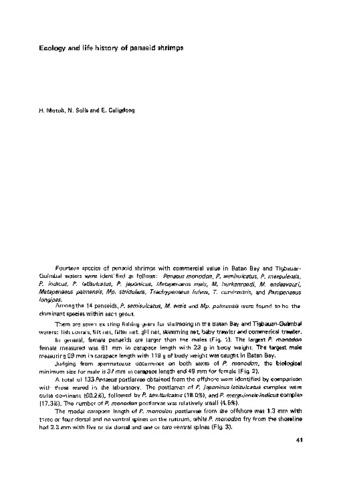Ecology and life history of penaeid shrimps
| dc.contributor.author | Motoh, Hiroshi | |
| dc.contributor.author | Solis, N. | |
| dc.contributor.author | Caligdong, E. | |
| dc.date.accessioned | 2015-07-20T01:36:28Z | |
| dc.date.available | 2015-07-20T01:36:28Z | |
| dc.date.issued | 1977 | |
| dc.identifier.citation | Motoh, H., Solis, N., & Caligdong, E. (1977). Ecology and life history of penaeid shrimps. SEAFDEC Aquaculture Department Quarterly Research Report, 1(2), 41-44. | en |
| dc.identifier.uri | http://hdl.handle.net/10862/2293 | |
| dc.description | Extended abstract only. | en |
| dc.description.abstract | Fourteen species of penaeid shrimps with commercial value in Batan Bay and Tigbauan-Guimbal waters were identified as follows: Penaeus monodon, P. semisulcatus, P. japonicus, Metapenaeus ensis, M. burkenroadi, M. endeavouri, Metapenaeopsis palmensis, M. stridulans, Trachypenaeus fulvus, and Parapenaeus longipes. Among the 14 penaeids, P. semisulcatus, M. ensis and M. palmensis were found to be the dominant species within each genus. There are seven existing fishing gears for shrimping in the Batan Bay and Tigbauan-Guimbal waters: fish corrals, lift net, filter net, gill net, skimming net, baby trawler and commercial trawler. In general, female penaeids are larger than males. The largest P. monodon female measured was 81 mm in carapace length with 23 g in body weight. The largest male measuring 59 mm in carapace length with 119 g of body weight was caught in Batan Bay. Judging from spermatozoa occurrence on both sexes of P. monodon, the biological minimum size for male is 37 mm in carapace length and 49 mm for female. A total of 133 Penaeus postlarvae obtained from the offshore were identified by comparison with those reared in the laboratory. The postlarvae of P. japonicus-latisulcatus complex were quite dominant (60.2%), followed by P. semisulcatus (18.0%), and P. merguiensis-indicus complex (17.3%). The number of P. monodon postlarvae was relatively small (4.5%). The modal carapace length of P. monodon postlarvae from the offshore was 1.3 mm with three or four dorsal and no ventral spines on the rostrum, while P. monodon fry from the shoreline had 2.3 mm with five or six dorsal and one or two ventral spines. | en |
| dc.language.iso | en | en |
| dc.publisher | Aquaculture Department, Southeast Asian Fisheries Development Center | en |
| dc.subject | Penaeidae | en |
| dc.subject | Philippines | en |
| dc.subject | Philippines, Batan Bay | en |
| dc.title | Ecology and life history of penaeid shrimps | en |
| dc.type | Article | en |
| dc.citation.volume | 1 | |
| dc.citation.issue | 2 | |
| dc.citation.spage | 41 | |
| dc.citation.epage | 44 | |
| dc.citation.journalTitle | SEAFDEC Aquaculture Department Quarterly Research Report | en |
| dc.subject.asfa | crustacean culture | en |
| dc.subject.asfa | morphology | en |
| dc.subject.asfa | commercial species | en |
| dc.subject.asfa | life history | en |


